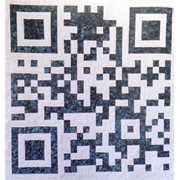I'm starting a new quilt, a very simple pattern: a single Irish Chain.
That means alternating blocks of 9-patches and squares. In this case, my 9-patches finish at 6.5 inches, and I have 6.5-inch squares in white. The 9-patches are in mixed tones and patterns of yellows. This is for my other cousin, whose favourite color is yellow, and he's older than me, and I had to use something I could do quickly!
But this time I tried, really tried, to use my noggin. For a change.
I started off cutting my white 6.5-inch strips the easy way, how you get it from the store, folded cleanly with the selvages meeting...It's a white-on-white, and it's not floral, it's geometric. Rectangles and faint lines.
My first (easy) cut was less than satisfactory, however, as the lines in the fabric didn't line up with the cut edges I had so carefully measured.
That was when I made myself stop and consider the problem of warp and weft.
The warp fibers are the ones firmly attached to the ends of the loom, at the top and bottom, as it were. In cotton, there is virtually no stretch at all along the warp, because these threads are pulled tight, tight, tight.
The weft is the horizontal threads, pulled through with the shuttle. As the shuttle reaches one end, it is turned back to go the other way. This leaves a finished edge, originally called a "self-edge," now shortened to selvage.
There is a little give in the weft - in a line from selvage to selvage. A teensy, ever-so-small bit of give.
Cotton fabric, even the best quilting cotton, stretches a bit along the weft.
Now, as quilters, we are all concerned with controlling stretch. And when I started off quilting many moons ago, I made every effing mistake it was possible to make concerning stretching my fabric!
I ironed the bejeezuz out of it with steam - which served to set in plenty of distortion. I pinned it up the yin-yang, which created lumps and bumps. I didn't cut accurately, which meant none of my squares or triangles ever fit, and I sewed a generous 1/4 inch seam instead of a scant 1/4 seam, which meant I had no room at all to square things off.
None of my blocks lined up with each other, and I was in tears most of the time. Because I didn't understand how fabric stretches, and how to use that knowledge to my advantage.
So on this day, I stopped cutting along the selvage (weft) of my fabric and took the time to open it up, turn it around, cut it into manageable-sized pieces and cut my 6.5 inch strips along the line of the warp.
And after that, I turned my strips over and drew a chalk line the length of that warp strip, so that when I cut it into squares, I'd be able to tell immediately which direction would stretch, and which direction wouldn't.
Now, when I go to sew my alternating blocks into rows, I will put my 9-patch up against the warp side of the square. Because I can tug at the 9-patch to make it fit the square, and the square isn't going to stretch vertically.
When I go to attach the rows, I will be using the faint stretch of the weft to compel the blocks to line up with each other at the seams.
In this way I am using the natural stretch to my advantage, for a change.
Pictures if it works!
Monday, April 16, 2018
Subscribe to:
Post Comments (Atom)






No comments:
Post a Comment